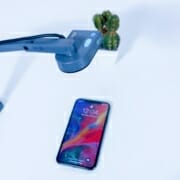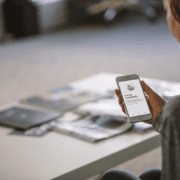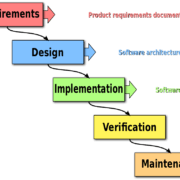UI/UX Design: 8 Trends In Mobile Apps Happening Right Now
The current UI/UX design trends are exciting because they represent the tastes of a maturing mobile market. Today’s users know what they want and what they find appealing. And seasoned app developers have a grasp of what kind of UI/UX design works and what is relevant. Thus, the quality bar is set high, but that doesn’t mean you can’t push it higher. If you plan on releasing an app in 2023 and beyond, read our handy list of design trends before forging ahead.
1. Next-Gen Application Programming Interfaces (APIs) Are Ready For Prime Time
Apple and the Khronos Group have done much work on their graphics APIs. Several years ago, Apple introduced Metal, a proprietary low-level API for handling impressive 3D graphics and shaders. Likewise, the Khronos Group introduced Vulkan, a powerful third-party API for various operating systems, mobile devices, and consoles.
These APIs replace the aging OpenGL API on both iOS and Android. Apple has officially moved over to Metal since iOS 8, but it’s a gradual process on Android since many older devices don’t support Vulkan. Furthermore, Apple doesn’t support Vulkan, but developers can use the MoltenVK library to run their Vulkan code on Metal with reasonably good performance.
But what does all this mean for you as a mobile developer or an appreneur? If any of your existing apps use OpenGL, it’s time to future-proof these with Metal on iOS and Vulkan on Android. You’ll substantially improve the visual quality and response times of your apps. And since 90 Hz and 120 Hz displays have become commonplace, users expect a snappy experience and next-gen UI/UX design to stay hooked.
However, if your apps don’t require the raw horsepower of complex APIs like Metal and Vulkan, there are better alternatives. If you want to display simple shapes and 2D objects, Google has introduced Skia, and Apple has SpriteKit for these purposes. Skia and SpriteKit also conform to the new design language, look, and feel that Google and Apple expect developers to follow. So, if you want your apps to have a truly native UI/UX design on both platforms, use these two APIs for optimal results.
USE OUR APP COST CALCULATOR TO ESTIMATE THE COST TO BUILD YOUR APP!
2. UI/UX Design Must Take A Sustainable Approach
Nowadays, you likely hear much about sustainability from environmentalists, intellectuals, influencers, policymakers, politicians, and even device manufacturers. That’s not surprising considering the considerable damage overconsumption does to the health of the planet and all its inhabitants. Damaged and disused smartphones, tablets, and laptops contribute to this problem via e-waste.
The rapid technological evolution and lack of repairability of mobile devices have made them highly disposable. Sadly, this results in large landfills filled with toxic components, which also negatively impact the health of e-waste workers. Of course, this problem hasn’t gone unnoticed by some consumer-centric manufacturers that plan to shake up the smartphone market.
A Dutch-based manufacturer recently announced the Fairphone 5, which boasts a five-year warranty and Android software updates until 2031. Furthermore, users can self-repair their phones — including the camera and battery — with an ordinary Phillips screwdriver. The goal is to prolong its lifespan, from something users often replace within two or three years to a phone that they could keep for five years or more.
But will the mobile device giants like Apple, Samsung, and Huawei follow suit, or will it be business as usual? While it’s impossible to foretell what the big three will do, a small but crucial revolution in sustainability has begun. A growing number of users are holding onto their phones for longer, with Europeans replacing their devices every 40 months and Americans at around 24 months.
That means you should plan your UI/UX design for devices that exceed their typical lifecycle of approximately two years. And when you update your user interface (UI), ensure it looks and works great on new and older devices.
3. Elegance And Simplicity Dominate Recent UI/UX Design Trends
Mobile devices have matured, yet so have users. Users don’t want to see an overly busy and colorful UI, as it lacks sophistication and hurts usability. Instead, they prefer neutral color tones, well-spaced and thought-out UI components, and intuitive button placement.
Even the choice of font plays a crucial role in winning over users. A clever way to impress your users is to use Blacker, Hermann, and Recoleta Serif fonts in your next app project. Not only do these Serif fonts look incredibly elegant, but they work well together with a range of background colors and textures. Moreover, users often recall words written with Serif fonts far better than with other fonts. So use Serif font for commands and menu options you want users to remember in the long term.
But what if you want to use 3D elements for your next app? Several years ago, 3D elements enjoyed reasonable popularity and gradually fizzled out. That doesn’t mean you shouldn’t use any 3D design elements, especially if it suits your app. An augmented reality (AR) app, Archviz walkthrough, or mobile game may need 3D design to express core concepts or even for usability.
4. Add A Splash Of Bright Neon Colors When Necessary
While you should never make your app look like a colorful mess, that doesn’t mean that you should avoid color altogether. The recent resurgence of the cyberpunk subgenre has had a massive impact on the wider culture. One of the biggest video games in recent years, Cyberpunk 2077, introduced its unique neon-drenched design language that many find incredibly appealing.
Let’s not forget about the recent Blade Runner 2049 movie and every Nicolas Winding Refn film that doesn’t go easy on the neon either. These cyberpunk-oriented examples teach us that bright colors and neon can make a scene or design element look truly stunning and memorable. Of course, a UI/UX designer with a trained eye for detail and knowledge of color theory will pull this off successfully.
But you may be wondering when it’s most suitable to use bright or neon colors. If you’re developing an educational, design app, or mobile game, you could benefit from using bright or neon colors, provided you color match correctly. Avoid taking this route for any business, fintech, or utility app, as it will make your application look less like a serious candidate for its target audience. And if you must use bright or neon colors for such an app, use them sparingly.
5. Every UI/UX Design Roadmap Should Encompass Foldables
Foldable smartphones are no longer niche and have gradually become commonplace for mainstream use. And even though foldables seem to be exclusively in the domain of the Android camp, speculation is rife that Apple will introduce their answer to the foldable phone soon. So whether you’re exclusively an Android or iOS developer or even a multiplatform developer, you can no longer ignore the foldable market.
However, foldable phones bring several challenges to the table that you can’t ignore either. The differing display sizes of various models and extra screen real estate means that you have to carefully plan your UI in greater detail than before. Your UI/UX design team must lay out every step of the interaction process when wireframing. They’ll need to carve out the user’s journey from the welcome page to any interactions necessary on the secondary outer display.
Also, your UI/UX design team must implement the correct gestures for navigating the larger screen. They must make the user’s journey as efficient and practical as possible so that users successfully navigate the app with as few gestures as possible. Furthermore, the team must refrain from adding unnecessary features just because there’s extra screen real estate. The last thing you want to do is make your app bloated, as this will increase its file size and possibly hurt its usability.
6. Design With Video Content In Mind
In 2023, you can’t ignore video, as it can profoundly impact the success of your app. While some may argue that not every app is suitable for video or needs to deliver this type of content, these naysayers may be missing the bigger picture. The truth is that video is a powerful medium you can integrate in just about any app today.
Even a simple to-do list app can benefit by having short video tutorials to explain all its functions. It’s not necessary to film actors doing these tutorials, but use stylized motion graphics and animations instead. Any competent UI/UX designer could use a tool like Figma to design and animate stunning tutorials. If you don’t have the staff or tooling to do this, consider teaming up with an experienced studio, such as NS804, to handle this for you and other aspects of your app’s development.
A side benefit of creating video content for your app is that you can also upload these videos to TikTok, YouTube, and Vimeo. These can act as marketing material for your app, as people who haven’t used your app yet may view them. If these tutorial videos do a great job explaining how to use your app, some viewers may download it and try it out. Those using a similar app or looking for a replacement may switch if your app seems more intuitive based on these tutorial videos and its actual usability.
7. Make UI And Transitions More Dynamic And Memorable
The look and feel of your UI say much about the quality of your app. If your UI looks appealing while feeling snappy, it will inevitably win over many users. But many apps in the marketplace already meet this standard, so how can you make your app stand out? Start by creating a more dynamic UI and transitions using a tool like Figma.
Figma or any similar UI tool will help you prototype and craft impressive motions for many of your UI components. Add movement in your UI to wow your users but ensure that it feels intuitive. For example, if your UI looks like it requires a diagonal gesture, then implement a diagonal-oriented movement to match the UI. Then, add a transition utilizing an animated diagonal split screen to move to the next page. All this will make your app more technically impressive and memorable.
You may take things further by adding sound effects that trigger during inputs and transitions. Yet, it’s these minor details that will ultimately set your app apart from its competitors.
Another UI design trend worth considering is using buttonless inputs and liquid swipes. It results in stunning-looking apps that feel next-gen. But it’s necessary to use large, bold text so users with disabilities can also navigate the app. Inclusive design should always be a core part of your upcoming app projects.
SCHEDULE A CONSULTATION WITH AN APP DEVELOPMENT EXPERT TO GET A CUSTOMIZED QUOTE!
8. Illustrations And Graphics Enhance UI/UX Design
While it’s possible to develop a visually appealing app with only text and background textures, this can also look bland. After all, users have become accustomed to receiving much visual stimulation from various sources like comic books, films, games, music festivals, and even modern storefronts. So, creating an app that may look boring to your potential users should never be on the agenda.
There are several ways to spruce up your app, but we recommend you try stylish, visually bold graphics or illustrations. Most modern mobile graphic designs consist of organic-looking shapes and figures. You may need to hire a graphic designer to create these, but your UI/UX design team may also handle this task.
If your app requires illustrations, this calls for someone with an entirely different skill set. If you’re a mobile game developer, you may already have hired one or more illustrators, so this shouldn’t be a problem. But if you don’t have an illustrator on your team, you may commission art from a freelancer on sites like ArtStation, Behance, and DeviantArt.
A talented illustrator will create artwork that can act as a story-telling tool, help differentiate your app, and even conceive a visual style tailored to your brand. The latter will help you build brand awareness and is a good strategy if you plan to work with the same illustrator on a long-term basis.
The Bottom Line
UI/UX design is a necessary part of the app development process that often takes center stage. Ideally, you should have at least one talented UI/UX designer on your team, but if you don’t, consider working with a professional studio. Contact NS804 to learn how we’ll help you develop apps with excellent design and usability.











 https://www.pexels.com/photo/black-and-silver-laptop-computer-on-round-brown-wooden-table-1181243/
https://www.pexels.com/photo/black-and-silver-laptop-computer-on-round-brown-wooden-table-1181243/ https://unsplash.com/photos/bMTl6uFMONg
https://unsplash.com/photos/bMTl6uFMONg
Leave a Reply
Want to join the discussion?Feel free to contribute!